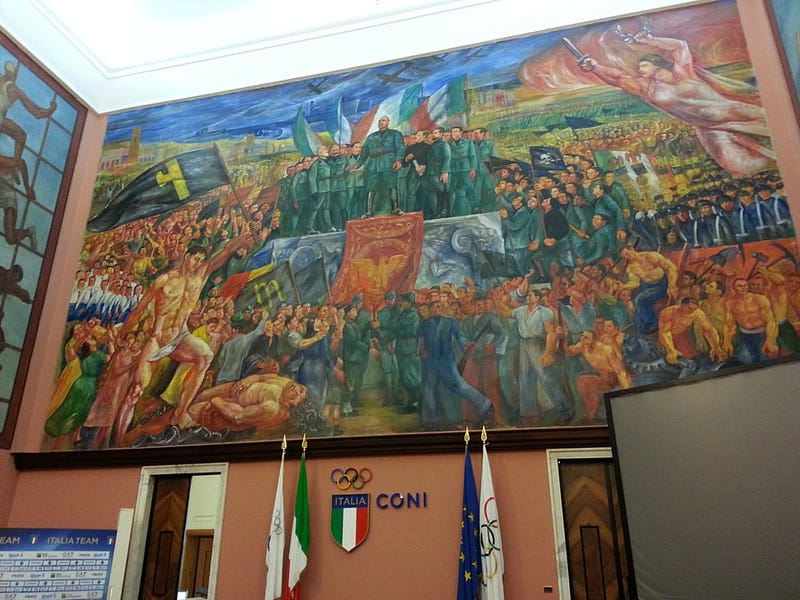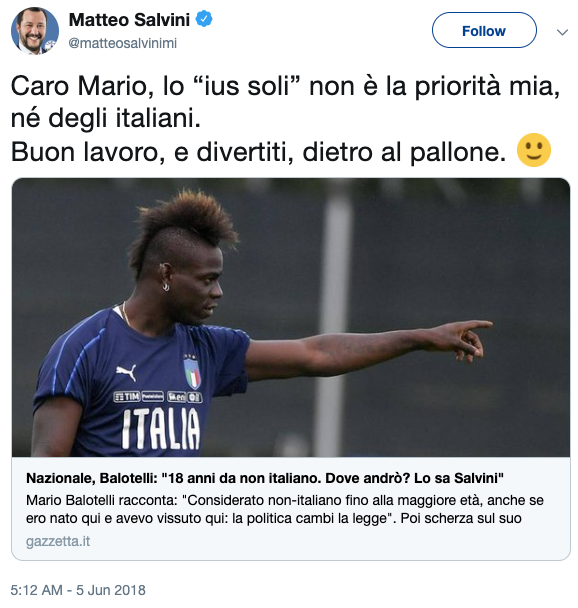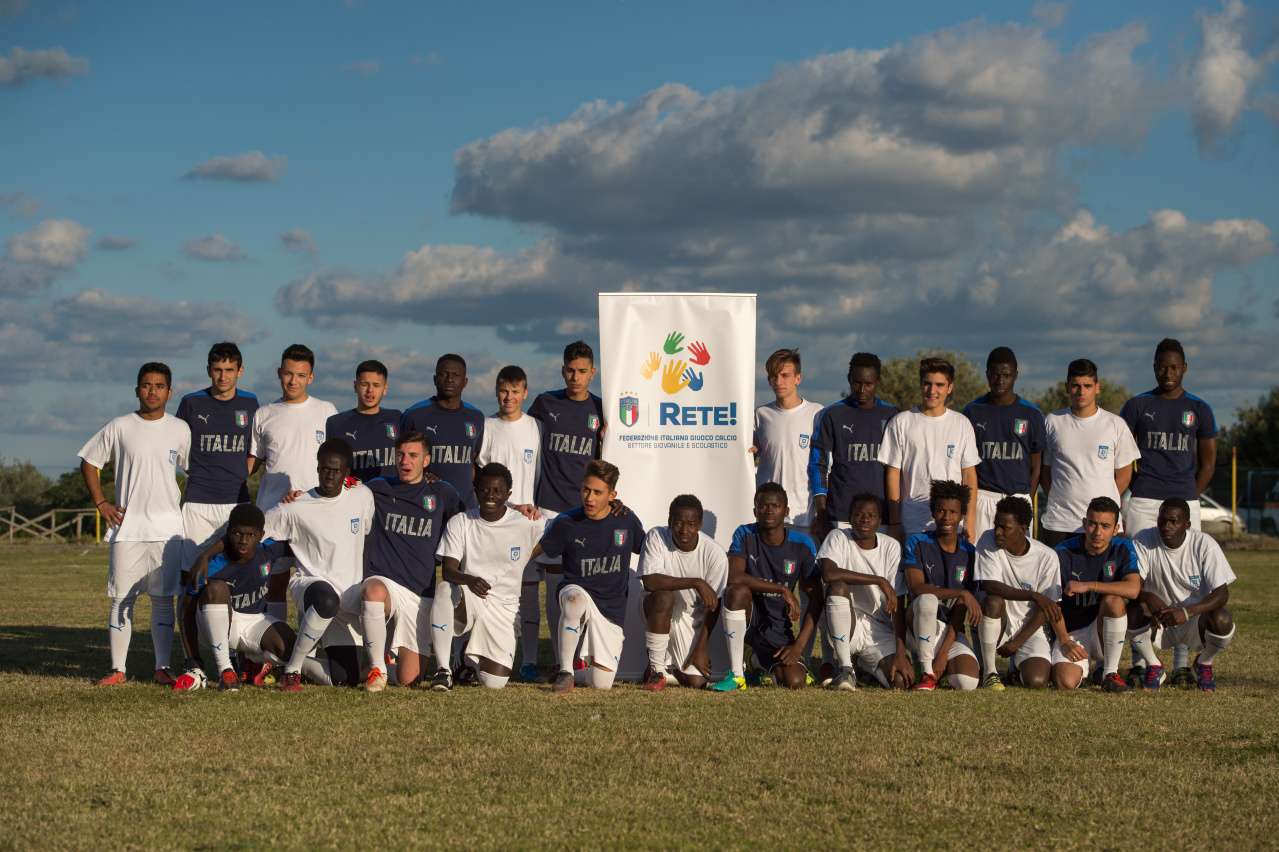Introduction
As Italy shifted from a country of emigration to immigration over the last few decades, it has struggled to accept its changing demographics. A country that was once known for sending its citizens around the world to the Americas, Australia, and throughout Europe, has now been absorbing migrants from north Africa, sub-Saharan Africa, Eastern Europe, the Near and Middle East, and Southeast Asia. Cities such as Rome, Milan, Florence and Naples have morphed into cosmopolitan centers born out of neo-liberalism, climate change, civil war, and globalization. An increase in diverse backgrounds, races, ethnicities, and religions has often been met with both passive and active resistance on the part of “native” Italians. One consequence has been the rise of racism and xenophobia and the consequent rise of populist and extreme political parties such as the Movimento Cinque Stelle and the Lega Nord, respectively.
In the last decade, the national pastime of calcio (the Italian word for soccer) has become a battleground of sorts. On the one hand, soccer games and stadia are the scenes of ugly incidents of racism and violence, often perpetrated by the Ultras (fanatical fans) of home teams. On the other hand, soccer has increasingly provided a vehicle for immigrants from all backgrounds to integrate themselves into the Italian social fabric. Local individuals, communities, and organizations have taken the lead here in the wake of the inaction and failures of the government and national entities.
While soccer has long been a pillar of Italian society, immigration has increasingly become one as well in recent years. Brought over in the late nineteenth century to port cities on the peninsula by Englishmen, calcio has a long and complex history. Used as a political tool by Benito Mussolini during the Fascist regime, the sport has remained in the national consciousness ever since. Soccer was used toward political ends by shipping magnate and power broker Achille Lauro, president of the Napoli team and mayor of the city (1952–1957). Most (in)famously, media mogul Silvio Berlusconi transformed his ownership of famed club A.C. Milan into a vehicle for his ascension into politics and eventually the office of Prime Minister (1994–95, 2001–06, 2008–11). Today, co-deputy Prime Minister and Minister of the Interior Matteo Salvini regularly attends soccer matches and gives his input about everything from soccer tactics to migration.
Research Question
The objective of this paper is to demonstrate how soccer and Italian soccer culture can help integrate immigrants and refugees into Italian society. While Italy has been shifting towards a country that receives immigrants, it was particularly affected by the recent European migration crisis. As soccer plays a large cultural role in Italy, working to bind together disparate class and ethnic groups, the sport can be used as a tool to help immigrants and refugees become acclimated to life in Italy by interacting with other Italians on and off the field, learning the language, and grasping the significance of a cornerstone of Italian culture.
Research Design
There are numerous examples of how soccer has and continues to help immigrants integrate into Italian society. Amateur clubs, which have been founded across the peninsula, specifically cater to immigrants. But problems persist. I encountered local organizations that work with immigrants which declined to discuss these topics, fearing retribution by the current Italian government. These organizations have now discreetly moved their operations under the radar or “off the grid” to avoid attracting attention from security forces.
Two years ago, in the spring of 2017, Syracuse University in Florence collaborated with an organization — Asics — which helped migrants transition in Italy. SUF invited some immigrants to play alongside Syracuse students in the local calcetto tournament. According to SU Italian instructor Vittoria Tettamanti, who worked with Asics, “the organization has since disbanded and no longer exists.”[1] We can speculate — but can’t prove — that it was disbanded because the national political climate was hostile to such an endeavor.
Literature Review
As this is an evolving and developing issue in Italy, not many academic articles have been written directly about the topic. Most work has been done either on immigration in Italy or soccer in Italy. The few works that do tackle both these topics directly is usually done by organizations such as the Union of European Football Associations (UEFA) and the United Nations Educational, Scientific and Cultural Organization (UNESCO) or written in Italian.
Max Mauro is the scholar who seems to have done the most work on this particular intersection of these two topics. His book, The Balotelli Generation: Issues of Inclusion and Belonging in Italian Football and Society,[2] was the resource most directly related to my research. The work consists of 40 interviews by the author with young soccer players in Italy aged 17–23 along with 30 interviews with coaches, administrators and migrants’ rights activists. Mauro was particularly interested in seeing if experiences of racism by the young players could undermine their sense of attachment and belonging to both the local community and the nation. Mauro also authored a paper examining immigrant youths participating in Italian soccer. He details the bureaucratic obstacles put in place by the Italian Football Federation many migrants face in registering to participate in youth soccer.[3]
Gabriele Abbondanza provides details on the shift of Italy as a country of emigration to a land of immigration. He also examines the legislation that was passed amid the consequential change. Abbondanza detects four different phases regarding Italy’s immigration laws: 1) the absence of a legal framework while Italy was still an emigration country (1880–1924); 2) the first regulations of the 1980s; 3) the policies influenced by both the European integration process and the increase in immigration until 2002 and, lastly, 4) the country’s controversial approaches since 2004.[4]
John Foot’s seminal work on Italian soccer, Calcio, provides much needed insight on how the sport became so ingrained into the country’s identity. A detailed history, it also highlights how soccer was used by Mussolini’s fascist regime, the formation of ultra groups, and racism in the sport.[5]
Raymond Siebetcheu led the MULTISPORT project at the University of Siena which systematically analyzes the linguistic and cultural dynamics in the context of sports migration.[6]
Elena Caneva gave a more broad, overall look at how Italy approaches the integration of immigrants. Her paper offers an insight into which social actors are involved in integration policies and how the issue is discussed in public and political discourses.[7]
Two reports from UEFA helped put the Italian scenario in a broader European context as well as in-depth information on specific initiatives taken by the Italian Football Federation.[8]
Background
For most of its short history, Italy had been a country of emigration. Roughly 26 million Italians emigrated from the peninsula from national unification in 1861 until 1976 and it only became a country of a positive migratory balance in 1973.[9] This drastic shift in a short period of time was compounded by the European migration crisis. Due to a convergence of issues, large numbers of migrants fled North Africa and the Middle East with the hope of reaching European soil. Situated as a peninsula jutting out into the Mediterranean Sea, Italy was the closest European destination for many of these migrants. Since the island of Lampedusa sits in the Mediterranean midway between the coast of North Africa and Sicily, it is often the first stop for desperate migrants and refugees. Due to the Dublin Regulation, Italy is obligated to handle the asylum applications for each person whose first entry in the European Union was Italy. The country’s bureaucratic infrastructure has struggled to properly handle these claims in a timely fashion. “As of 31 March 2019, there were 121,994 asylum-seekers accommodated in reception facilities across Italy, ” which was down 30% from the previous year.[10] These are just simply the number of people who are being officially accommodated by the Italian government as they await a response regarding their legal status; it doesn’t count people who entered the country without proper documentation or who didn’t claim asylum status. There has also been a drastic shift in policy since the current government was elected in March 2018. Under the new Minister of the Interior, Matteo Salvini, leader of the anti-immigration Lega party, Italy has now closed its ports to incoming rescue boats and has changed how migrants await their applications for asylum. Previously, migrants would be placed in the System of Protection for Refugees and Asylum Seekers (SPRAR) where they would be guided into a transition of how to live in Italy self-sufficiently. But now, due to the law known as the Salvini Decree, migrants are being placed in Centri di accoglienza straordinaria[11] (CAS) where they are not taught the language or any skills and are under a strict regimen and curfew.[12] These CAS centers are run by private companies and offer little-to-no services for the migrants as they await to hear about their legal status.[13] These CAS sites are more like internment camps than welcoming centers.
Historically, Italy has not tried to use soccer, or sport for that matter, as a method of helping integrate immigrants. Italian integration policies mostly concentrate on economic integration, whereas social and cultural policies remain marginal.[14]
Calcio is more than just a sport in Italy; it is a cultural phenomenon that cuts across social classes and informs daily life. It doesn’t just take place on the weekend, but is always present for even casual fans, stirring conversations and arguments throughout the week, taking place in conversations in cafes, the workplace and supporters’ clubs.[15] While Italy is a relatively young and regionally-divided nation, soccer has formed a powerful glue around which a national identity has been able to form.[16] Paradoxically it also reinforces regional differences and division as local clubs often command greater loyalty than the national team.[17]
Even the famed Italian philosopher and one of the founders of the Italian Communist Party, Antonio Gramsci, noted in 1935 that La Gazzetta dello Sport, the daily newspaper dedicated solely to sports and mainly soccer, was the most read newspaper in his Milan jail, including with politicians.[18] Even today, La Gazzetta dello Sport, with its famous pink pages, is the most read daily newspaper in Italy.[19] In a country with a sluggish economy, high unemployment, a divisive government, an immigration crisis, and many other problems, the most dramatic headlines are reserved for soccer.[20]
As it became the national sport during the Fascist era, there continues to be a strong nationalistic sense around the game. Mussolini set about restructuring the sport and molding it to respond to the regime’s needs as a tool of propaganda and national identity.[21] Still today, in the Salone D’Onore of CONI (The Italian National Olympic Committee) there is an “enormous mural of Il Duce surrounded by admiring black-shirted fascist officials.”[22]

This continuity from the Fascist era is even more palpable at many stadiums. During the politically turbulent 1970s and 1980s in Italy, the formation of Ultras became widespread. The term derives from ultra-fanatical and “indicates hardcore fans that manifest behaviours that exceed those considered normal and traditional.”[23] These ultra groups gained increasing notoriety and power.
The rise of the ultra movement in Italy in the 1970s was closely associated with political movements on both the left and right but this association waned in the 1980s. The political neutralisation of ultra groups in the 1980s favoured the re-emergence of extreme right groups in the grounds and from the end of the 1980s racism against immigrants became increasingly common at Italian grounds.[24]
Racism is still very present in the game both in Italy and across Europe. This season alone, there have been multiple incidents in Serie A, Italy’s top league. Kalidou Koulibaly, Tiemoue Bakayoko, and even 19-year-old Italian Moise Kean have all been subject to racist chants from opposing fans during the current 2018–19 season. Following the racist abuse towards Kean, Piara Powar, the executive director of Football Against Racism in Europe (FARE), poignantly and precisely analyzed the problem:
Italy in particular has got a very big problem; I would go as far as to say it’s an epidemic. I think part of the problem in Italy is the rhetoric of the right-wing government. It’s anti-migrant and anti-African and clearly that will always feed into stadiums. Then you have a football association that doesn’t know how to respond, given the government’s position, and historically hasn’t responded very well.[25]
As the Italian Football Federation continuously fails to hand out significant punishments to either the fans or the clubs, these incidents continue to occur. While the legal system in Italy does provide a well-established set of rules to fight racism in football, the greatest difficulty concerns the implementation of those rules.[26] Unsurprisingly, this racism trickles down to the youth level as “black youth of immigrant background in Italy describe racist abuse as being ‘part of the game’ and something one needs to adapt to.”[27]
Throughout calcio’s history, there has been documented discrimination towards foreigners. As early as 1908, the Federazione Italiana del Giuoco Calcio[28] (FIGC) passed a law stating that all teams with foreign players would be excluded from the main championship.[29] While that rule was rescinded the following year, the 1926 Viareggio Charter reinstated a ban on foreign players but became more ambiguous considering the inclusion of oriundi, those born outside Italy with Italian ancestry, in the national dialogue.[30] An historical irony is that Italy could not have won the World Cup in 1934 and again in 1938, without the play of several oriundi from Argentina and Uruguay.
Foreign players have become yet again a topic of controversy in recent years. When Italy won the FIFA World Cup in 2006, some complained that Mauro Camoranesi, born in Argentina, was the only player who did not sing the national anthem. When asked about it, Camoranesi said, “My kids sing it; I don’t know it. I don’t even sing my own [the Argentine anthem].”[31] The issue also came up at the 2014 FIFA World Cup as then-secretary of the Lega, Matteo Salvini proclaimed, “there are too many oriundi on this national team. I, at most, would allow three foreigners per team.”[32] In reality, there were only three oriundi on that team: Thiago Motta born in Brazil, Gabriel Paletta born in Argentina, and most notably Mario Balotelli, who was born in Palermo to Ghanaian parents. As the son of Ghanaian immigrants, raised by adoptive Italian parents, Balotelli symbolizes the transformations in Italy as it comes to terms with its contemporary multiculturalism.[33] Balotelli is an intriguing case who represents a growing portion of the Italian population. Despite being born in Italy, Balotelli had to wait until turning 18 years old to apply for Italian citizenship as his parents were foreign nationals in accordance with the jus sanguinis law.[34] Balotelli serves as a model for many youngsters who, despite being born in Italy, are often excluded from citizenship. As 22-year-old Adom, an Italian citizen, also from Ghanaian descent puts it succinctly:
Before Balotelli I did not feel very represented by the [Italian] national team, even though I adore football. I felt more represented by Udinese, the team of my hometown, the place where I was born, rather than the national team. Maybe this is also due to the fact that my family would support Ghana. But when Balotelli started playing with the national team it was different. I could identify with him. His story reflects my own. This is why I love him.[35]
Balotelli has actually been an outspoken critic of Salvini and the current government. Speaking out about the racism he faced while growing up in Italy, Balotelli called on Salvini to change the Italian law to “Ius Soli,” or right of the soil, that would grant citizenship to anyone born on Italian soil, including children of immigrants.[36] Salvini responded with a snide remark on Twitter; “Dear Mario, the ‘Ius Soli’ isn’t my priority or that of Italians. Work well and have fun, behind the ball.”[37]

Interestingly, compared to other major European leagues, Serie A has a high proportion of international players,[38] with 57.5% of players coming from abroad in the 2015–16 season.[39] Most professional teams do not care about the integration of foreign players. They consider the players a commodity that must immediately perform but “they do not realize that performance is closely related to the well-being [of the player].”[40]
Analysis
Most initiatives to help migrants integrate into Italian society have occurred at the local and regional level, while little has been done at the national level. In Italy, youth football is organized by local and regional organizations, so this is not surprising. Even integration policies themselves are usually “decided and implemented by regions and municipalities.”[41]
Between 2007–2014 there were 10 amateur soccer clubs formed for, and composed primarily of, refugees operating in different geographic areas of Italy.[42] Formed in 2007 in Rome, Liberi Nantes was the first team in Italy entirely composed of refugees and asylum seekers.[43] “I want to make them [the players] understand that, if they want to help themselves in this difficult society, soccer is a way to understand how society works,” said Liberi Nantes head coach Salvatore Lisciandrello.[44] They play in Terza Categoria, the lowest amateur division and are unable to ever earn promotion due to the FIGC’s restriction on the number of foreign players on each team. One of the biggest professional clubs in Italy, A.S. Roma, has recognized Liberi Nantes’ important work in the city and the clubs have started a collaboration together.[45]
Having these organizations at a local level can be essential for recently arrived migrants. It presents an important opportunity to meet people both from a similar background but also natives of Italy. “I feel happy when playing football. In the beginning I didn’t know anyone but playing football helped me get to know people. We are like a family and are there for each other,” said 16-year-old Abubacarr Konta who arrived in Sicily from Gambia. “Football unites people. That’s what I love about the game.”[46] This is an example of how the sport can provide vital social support for young migrants. Despite arriving in a new country alone without speaking the language, Konta can connect with others through soccer as it is a universal language. “This story clearly illustrates that football can be an important tool for the integration of migrants in Europe,” UEFA President Aleksander Čeferin said. “I am pleased that this project in Sicily, supported by the FIGC, is helping young African migrants integrate into European society and culture.”[47]
Yet there are also many difficulties even at the local and regional level. Non-EU minors are requested to submit eight documents in order to register for a youth club while Italian citizens only need to submit one.[48] This affects many children who, despite being born in Italy, but without parents born in Italy, are not able to even apply for Italian citizenship until they turn 18 years old. “Today, due to the restrictions imposed by the Italy’s citizenship law, many talented athletes, both male and female, are prevented to represent Italy despite having lived in Italy for most of their lives and even being born in this county.”[49] Another issue is that regional branches sometimes have different guidelines than what is imposed by the FIGC. For instance, the regional branches of Abruzzo and Tuscany each held different standards for registration in comparison to the FIGC for the 2014–15 season.[50] These bureaucratic obstacles only make it more difficult for young children of immigrant backgrounds to find an outlet through soccer to become more in touch with their community and earn a sense of belonging.
The main nationwide initiative is a program established by the Italian Football Federation called Rete! Literally translated as “net,” the term is usually the word to signal when a player scores a goal. Launched in 2015, the program “targets unaccompanied foreign children who live in SPRAR centres” and “aims to promote social inclusion, peer interaction and intercultural dialogue through educational and football-oriented activities.”[51] Each year has seen an increase in participants along with increasing success. With 237 participating youngsters in 2015, there are 560 registered for the 2019 edition.[52] Although, as the Ministry of the Interior plays a key institutional role,[53] the program’s future could be in doubt considering Matteo Salvini now holds that post. That will hopefully not be the case as the program has already yielded successful results. A study conducted in collaboration with the Università Cattolica del Sacro Cuore in Rome concluded that it “is possible to observe positive changes towards greater emotional stability and social inclusion thanks to this project, as well as benefits derived from increased social exchanges with other young people through football-related activity, such as improved wellbeing, increased happiness, a greater sense of freedom and a reduction in loneliness.”[54] These potential positive effects of soccer clearly transcend the field. The FIGC should take on a larger role in this capacity, looking to implement more programs similar to Rete! in order to provide these opportunities and learning experiences for a larger number of children.
Conclusions
As it is the global sport, many migrants who come to Italy already have some experience with the game of soccer. Due to calcio’s significance in Italian culture, the sport can play a special role in helping immigrants and refugees adjust to life on the peninsula. Soccer can provide a sense of social structure and support that many young migrants lack due to the fact they traveled to Italy alone. There are circumstances that make this tool of integration difficult, notably bureaucracy, nativist notions associated with soccer due to the Fascist era, institutionalized racism, and the current Italian government. The current government, specifically Minister of Interior and co-deputy Prime Minister Salvini, has shown no interest in making any attempts to help integrate immigrants. In fact, they are making it more difficult, closing the ports to incoming boats and placing migrants in CAS centers, expending no effort and offering no resources to help them adjust to life in Italy. Despite the combativeness of this government, local clubs and organizations have been making significant efforts to provide real opportunities for many immigrants, refugees, and asylum seekers. They see the potential benefits in providing an outlet through soccer to improve the social well being of immigrants, refugees, and asylum seekers and help them adapt to Italian society and culture.
WORKS CITED
Abbondanza, Gabriele. “Italy’s Migration Policies Combating Irregular Immigration: from the Early Days to the Present Times.” The International Spectator, 2017, 52:4, 76–92.
Agnew, Paddy. Forza Italia: A Journey in Search of Italy and its Football. London: Random House, 2006.
Caneva, Elena. “The integration of migrants in Italy: an overview of policy instruments and actors.” Robert Schuman Centre for Advanced Studies, San Domenico di Fiesole (FI): European University Institute, 2014.
Della Torre, E., Giangreco, A., Legeais, W., and Vakkayil, J. “Do Italians Really Do It Better? Evidence of Migrant Pay Disparities in the Top Italian Football League.” European Management Review, 2018. 15: 121– 136.
Doidge, Mark. “‘If You Jump up and down, Balotelli Dies’: Racism and Player Abuse in Italian Football,” International Review for the Sociology of Sport, 50: 3, May 2015, pp. 249–264.
Donadio, Rachel. “It’s the Right Wing’s Italy Now,” The Atlantic, 6 June 2018. https://www.theatlantic.com/international/archive/2018/06/its-the-right-wings-italy-now/562256/
Dossier Statistico Immigrazione 2015, Centro Studi e Ricerche IDOS, Rome, 2015.
FIGC. “Salute e migrazione: il Progetto Rete! un modello a livello internazionale” 6 March 2019. https://www.figc.it/it/giovani/news/salute-e-migrazione-il-progetto-rete-un- modello-a-livello-internazionale/
Foot, John. Calcio: A History of Italian Football. New York: Harper Perennial, 2007.
Herman, Martyn. “Italy facing racism ‘epidemic’ says, FARE chief,” Reuters, 3 April, 2019. https://uk.reuters.com/article/uk-soccer-italy-racism/italy-facing-racism-epidemic-says-fare-chief-idUKKCN1RF249
Huffington Post. “Mondiali 2014. Matteo Salvini: ‘Troppi oriundi nella nazionale italiana’” 23 June 2014 https://www.huffingtonpost.it/2014/06/23/mondiali-2014-salvini-troppi-oriundi-in-nazionale_n_5522141.html
Kassimeris, Christos. “Fascism, separatism and the ultràs: discrimination in Italian football,” Soccer & Society, 2011, 12:5, 677–688.
Martin, Simon. “Football, Fascism and Fandom in Modern Italy,” Revista Critica de Ciencias Sociais. 2018, 116, 111–133.
Mauro, Max. The Balotelli Generation: Issues of Inclusion and Belonging in Italian Football and Society. Bern, Switzerland: Peter Lang, 2016.
Mauro, Max. “Inclusive sport or institutional discrimination? New FIFA regulations, organized football and migrant youth in Italy,” Sport in Society, 2017, 20:7, 833–847.
La Gazzetta dello Sport. “Camoranesi: ‘L’inno? Non conosco neanche il mio,” 4 June 2006, https://www.gazzetta.it/Speciali/Mondiale_2006/Primo_Piano/2006/06_Giugno/14/camor anesi.shtml
“Liberi Nantes: the first football team in Italy made up of refugees | Guardian Football Passport.” YouTube, uploaded by The Guardian, uploaded 1 October 1 2015, https://www.youtube.com/watch?v=dv2hnzz5FzU&t
Parks, Tim. “Italy’s Soccer Apocalypse,” The New Yorker, 16 November 2017.
Siebetcheu, Raymond. “Language Barriers in Sports: the case of Italian Professional Football,” Challenging Language Barriers in the Public Service, Aracne Editrice, January 2016.
Sonntag, Albrecht and David Ranc. “Colour? What Colour? Report on the Fight Against Discrimination and Racism in Football,” United Nations Education, Scientific & Cultural Organization (UNESCO), 2015.
Spini, Debora. PSC300: Politics of Immigration in Europe, Class Lectures, Syracuse University in Florence, Spring 2019.
Testa, Alberto and Gary Armstrong. “Words and actions: Italian ultras and neo-fascism,” Social Identities: Journal for the Study of Race, Nation and Culture, 2008, 14:4, 473–490.
UNHCR. “Italy fact sheet — March 2019,” United Nations High Commissioner for Refugees, https://data2.unhcr.org/en/documents/details/69316
UEFA, “Promoting Inclusion, Diversity and Acceptance Through Football in Italy,” UEFA
Direct, March 2018, 175.
UEFA, “Football and Refugees — Addressing key challenges,” October 2018, https://www.uefa.com/MultimediaFiles/Download/uefaorg/General/02/57/60/20/2576020_DOWNLOAD.pdf
[1] Personal email communication, 3 April 2019.
[2] Max Mauro, The Balotelli Generation: Issues of Inclusion and Belonging in Italian Football and Society (Bern: Peter Lang, 2016).
[3] Max Mauro, “Inclusive sport or institutional discrimination? New FIFA regulations, organized football and migrant youth in Italy,” Sport in Society, 2017, 20:7, 833–847.
[4] Gabriele Abbondanza, “Italy’s Migration Policies Combating Irregular Immigration: from the Early Days to the Present Times,” The International Spectator, 2017, 52:4, 76–92.
[5] John Foot, Calcio: A History of Italian Football, (New York: Harper Perennial, 2007).
[6] See the Multisport website: https://www.unistrasi.it/1/569/2981/MULTISPORT.htm
[7] Elena Caneva, “The integration of migrants in Italy: an overview of policy instruments and actors,” Robert Schuman Centre for Advanced Studies, European University Institute, 2014.
[8] UEFA, “Promoting Inclusion, Diversity and Acceptance Through Football in Italy.” UEFA Direct, March 2018.
[9] Abbondanza, p. 77.
[10] UNHCR.
[11] Translates as Emergency Reception Centres.
[12] Professor Debora Spini, class discussion, SUF, Spring 2019.
[13] Ibid.
[14] Caneva, p. 7.
[15] Mark Doidge, ‘If You Jump up and down, Balotelli Dies’: Racism and Player Abuse in Italian Football,”
International Review for the Sociology of Sport, 50:3, May 2015, pp. 249–264.
[16] Foot, p. 473.
[17] One notorious example of this was how fans of Napoli rooted for Argentina and their star, Diego Maradona, in the 1990 semifinal of the World Cup, after Maradona, who had recently won a championship for Naples, asked the fans to support Argentina the night before the match against Italy in Naples.
[18] Mauro, pp. 21–22.
[19] According to a national survey promoted by the Italian Federation of Newspapers Publishers, in September 2018, La Gazzetta dello Sport had 3,274,000 readers in print and/or digital, while Corriere della Sera, the second most read daily, had 2,067,000, Audipress Report 2018, http://www.audipress.it/visual_report/
[20] Tim Parks, “Italy’s Soccer Apocalypse,” The New Yorker, 16 November 2017.
[21] Simon Martin, “Football, Fascism and Fandom in Modern Italy,” Revista Critica de Ciencias Sociais, 116, 111–133.
[22] Paddy Agnew, Forza Italia: A Journey in Search of Italy and its Football. (London: Random House, 2006), p. 57; see Figure 1
[23] Testa and Armstrong, p. 476.
[24] Kassimeris, p. 681.
[25] Herman, https://uk.reuters.com/article/uk-soccer-italy-racism/italy-facing-racism-epidemic-says-fare-chief-idUKKCN1RF249
[26] Sonntag, p. 40.
[27] Mauro, p. 15.
[28] Official name of the Italian Football Federation.
[29] Foot, p. 37.
[30] Ibid, p. 38.
[31] La Gazzetta dello Sport, 4 June 2006.
[32] Huffington Post. In the same conversation, Salvini referred to foreign players as “mercenaries.”
[33] Doidge, p. 249.
[34] Mauro, p. 835.
[35] Mauro, p. 130.
[36] Donadio, https://www.theatlantic.com/international/archive/2018/06/its-the-right-wings-italy-now/562256/
[37] See Figure 2.
[38] Della Torre, et al., p. 125.
[39] Siebetcheu, p. 153.
[40] Ibid, p. 155.
[41] Caneva, p. 15.
[42] Dossier Statistico Immigrazione, p. 228.
[43] The Guardian, YouTube video.
[44] Ibid.
[45] Ibid.
[46] UEFA, March 2018, p. 25.
[47] UEFA, March 2018, p.25.
[48] Mauro, p. 837.
[49] Mauro, pp. 23–24.
[50] Mauro, p. 841.
[51] UEFA, March 2018, p. 22.
[52] FIGC, https://www.figc.it/it/giovani/news/salute-e-migrazione-il-progetto-rete-un-modello-a-livello-internazionale/
[53] UEFA, October 2018, p. 22.
[54] UEFA, March 2018, p. 25.









